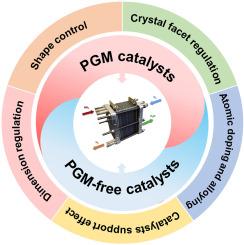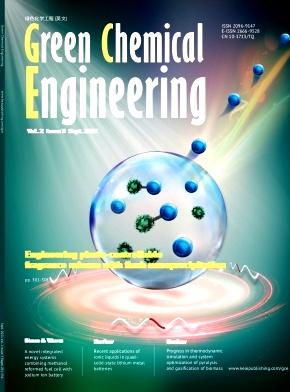低温直接氨燃料电池催化剂的设计和性能评估进展
IF 9.1
Q1 ENGINEERING, CHEMICAL
引用次数: 0
摘要
氨是一种富氢、无碳的能源载体,具有能量密度高、液化储存方便等优点,是氢储存的最佳介质。低温直接氨燃料电池(DAFC)是高效利用氨能的一条极具前景的途径。然而,低温氨氧化反应(AOR)的动力学缓慢,需要高负载的铂族金属(PGMs)催化剂,其中毒现象严重影响了氨燃料电池的性能,从而限制了其大规模商业应用。因此,设计高效、经济、稳定的催化剂至关重要。本文详细回顾了近期旨在阐明 AOR 潜在机理的研究工作。在此知识基础上,讨论了 AOR 的 PGM 和无 PGM 催化剂的设计和合成进展,以及用于 DAFCs 的膜电极组件 (MEA) 制备工艺。此外,还总结了 AOR 催化剂在单电池测试中的性能评估结果。最后,根据我们迄今为止在这一研究领域的发现,提出了可促进低温 DAFCs 快速发展的 AOR 催化剂潜在设计策略。本文章由计算机程序翻译,如有差异,请以英文原文为准。

Progress in the design and performance evaluation of catalysts for low-temperature direct ammonia fuel cells
Ammonia, a hydrogen-rich and carbon-free energy carrier, possesses advantages such as high energy density and convenient liquefaction storage and serves as an optimal medium for hydrogen storage. Low-temperature direct ammonia fuel cells (DAFCs) represent a highly promising pathway for the efficient utilization of ammonia energy. However, the sluggish kinetics of the low-temperature ammonia oxidation reaction (AOR), requires high loading of platinum-group metals (PGMs) catalysts, and their poisoning significantly hampers the performance of DAFCs, thereby limiting their large-scale commercial application. Therefore, it is crucial to design efficient, cost-effective, and stable catalysts. In this work, a detailed review of recent research efforts aimed at elucidating the mechanism underlying the AOR is presented. Building on this knowledge base, progress in the design and synthesis of both PGM and PGM-free catalysts for the AOR is discussed, as well as membrane electrode assembly (MEA) preparation processes for DAFCs. Furthermore, the results of the performance evaluation of AOR catalysts in single-cell tests are summarized. Finally, based on our findings from this research area thus far, potential design strategies for AOR catalysts that can promote the rapid development of low temperatures DAFCs are proposed.
求助全文
通过发布文献求助,成功后即可免费获取论文全文。
去求助
来源期刊

Green Chemical Engineering
Process Chemistry and Technology, Catalysis, Filtration and Separation
CiteScore
11.60
自引率
0.00%
发文量
58
审稿时长
51 days
 求助内容:
求助内容: 应助结果提醒方式:
应助结果提醒方式:


